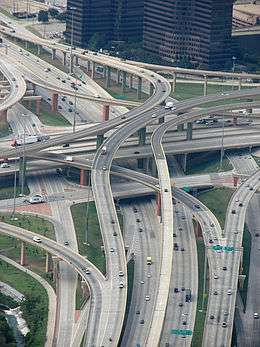Split intersection
.svg.png)
Split intersection
A Split Intersection is a rarely built at-grade variant of the diamond interchange.[1] Compared to a conventional four leg intersection or road crossing, the artierial road is being split-up into separated carriageways by 200 to 300 feet, allowing a queue of left turning vehicles behind a completed turn into the crossroad without any conflict to oncoming traffic. On the crossroad, the four leg intersection is being replaced by two intersections. The beginning one-way traffic at the fourth leg makes the intersecions reduce the number of conflicts similar to a three leg T-intersection to improve traffic flow.[2][3]
Existing intersections
- At Legacy Drive and Preston Parkway, Plano, Texas, with Texas U-turn lanes, 33°04′15″N 96°47′46″W / 33.070835°N 96.796246°W
- At New Dallas Highway (US-77) and E. Industrial Boulevard TX-340 in Lacy Lakeview, Texas, 31°36′19″N 97°06′39″W / 31.605353°N 97.110952°W
- At Stock Road and Winterfold Road in Perth, Australia
Further reading
- Simulation of the Split Intersection, ATTAP, University of Maryland, 11 November 2015
See also
References
- ↑ Joe G. Bared and Evangelos I. Kaisar: Advantages of The Split Intersection, Federal Highway Administration, Issue No: Vol. 63 No. 6, June 2000
- ↑ Joe Bared, Evangelos Kaisar: Benefits of Split Intersections, Transportation Research Board, DOI 10.3141/1737-05
- ↑ Federal Highway Administration: Signalized Intersections: Informational Guide, Chapter 10.3.1, publikation number FHWA-HRT-04-091, 2004 (PDF)
This article is issued from Wikipedia - version of the 9/10/2016. The text is available under the Creative Commons Attribution/Share Alike but additional terms may apply for the media files.

